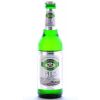Brauerei Grieskirchen - Grieskirchner Pils
-
ABV:
4.8% -
Serving Temperature:
40-45° F -
Suggested Glassware:
Pilsner Glass

Light golden with crystal clarity and a tight crop of bright white foam, this brew certainly looks the part of a German-style pils. On the nose, look for lightly sweet pils malts to contribute mild notes of pale bread dough and saltine crackers. Overlaying the malt is a quintessential European-style noble hop aroma contributing herbal grassiness, earthy tones, and just a touch of lemony acidity, while hints of sulfur pop through as well, which is common to pilsners and often lager yeast in general. On the palate, expect a pleasant touch of sweetness within the crackery notes, satisfyingly balanced by a nice dose of hop bitterness. Right on target for the style, and just what we expect from a pilsner hailing from this part of the world, the hops come through with a grassy character and a lightly lemon-like citric acidity to add a tart hint to the equation. When one tastes a real European pils made with 100% barley malt and a proper dose of noble hops, it’s easy to see how the style ended up sweeping the world. Pair this refreshing Austrian pilsner with – what else? – Weisswurst or Wiener Schnitzel. Of course, pizza is always a good pilsner pairing as well. Cheers!
This month we bring you two brews from just ‘south of the border.’ In this case, the reference point is not the USA, but Germany and the Czech Republic (great brewing nations both) and the brewery is located just south of where the borders of both nations intersect. Got your geography caps on? We are of course talking about Austria, a nation which itself is home to a mighty brewing heritage. The capital city, Vienna, can actually claim three beverages of national interest: coffee, left by the Turks in the late 17th century, a robust wine industry, and beer, which not surprisingly is our personal favorite.
The history of our favorite Austrian beverage is perhaps the most impressive of the three. At one point in the mid-1800s, an Austrian brewing family, led by Anton Dreher, controlled the largest business conducted under one management in continental Europe. And at a time when beers from Munich were still dark brown, Vienna featured unique beers that bore a paler, reddish-amber color, from which many brewers have since drawn inspiration. We take for granted today that beer can come in just about every shade, from ultra pale straw to inky black, but this was not always the case and the reddish amber hues found in Vienna’s beers contributed greatly to the color palette, and flavor profile, of beer. And, any homebrewers or professional brewers out there will recognize the familiar term “Vienna malts,” which are no longer made exclusively in Vienna (or even Austria) but are still used today to contribute reddish hues and toasty notes to today’s beers.
Austria’s role, albeit contested over the years, in the development of pale lager beers is impressive. Until the mid-1800s, all commercially produced, bottom-fermenting (lager) beer was rather dark in hue. But around 1841, the first lighter-colored lager was born. And while the Czechs get credit for picking up the trend shortly thereafter and creating the world’s most popular style of beer, Pilsner (which is a specific type of pale lager invented in the Bohemian town of Pilsen), light-colored lager was born in Austria. This major brewing development came about in a spirit of collaboration between a Munich brewer, Gabriel Sedlmayr, and Anton Dreher, during a visit to Dreher’s Vienna plant in 1841. As you can imagine, this caused much debate between Munich and Vienna over the years as to the origin of lager beer, enough so that Adolph Hitler himself ordered a commission of inquiry on the matter. In 1942, the commission ruled that it was in fact Dreher who had produced the first modern lager beer. Perhaps the fact that the Nazi party came to this determination led to less touting of the declaration than would have otherwise ensued if a different political entity had performed the research.
Almost exactly midway between Munich and Vienna lies the small town of Grieskirchen, Austria. For over 300 years, Brauerei Grieskirchen has brewed beer here using only traditional methods and local ingredients. The flagship of the brewery is their Grieskirchner Pils, featuring local, aromatic hops. And, while Bavaria has its famous beer purity law known as the Reinheitsgebot of 1516, the Austrians have their own purity law laid out in the Codex Alimentarius of the Hapsburg period (the Hapsburgs were the ruling family of Austria and the Austro-Hungarian empire, 1278-1918, and the Holy Roman empire from 1438-1806). Like the Reinheitsgebot, it too restricts beer to a handful of specific ingredients, but whereas the German law originally mandated barley as the only permissible grain, the Austrian law required that beer be made with water, hops and “cereals,” which is less restrictive and, in fact, permits wheat to be used to produce beers. Even under the Reinheitsgebot, wheat beers were in high demand—but initially they could not legally be produced by most brewers in Bavaria, so naturally a market for them sprang up in Grieskirchen, a border town just at the eastern edge of Bavaria. Thus was born a proud tradition of Austrian wheat beers, and we’ve proudly procured one of Austria’s best for you to try. Enjoy both of these tasty Austrian beers, for each bottle presents the opportunity to taste a little bit of history. Prost! If you read German and would like more information about the brewery, check out their website at www.grieskirchner.at.

Unmatched Variety by style, brewery & country
Choose from Five different Beer Clubs offering unmatched variety by brewery,
country of origin, and beer style to suit your specific tastes.


